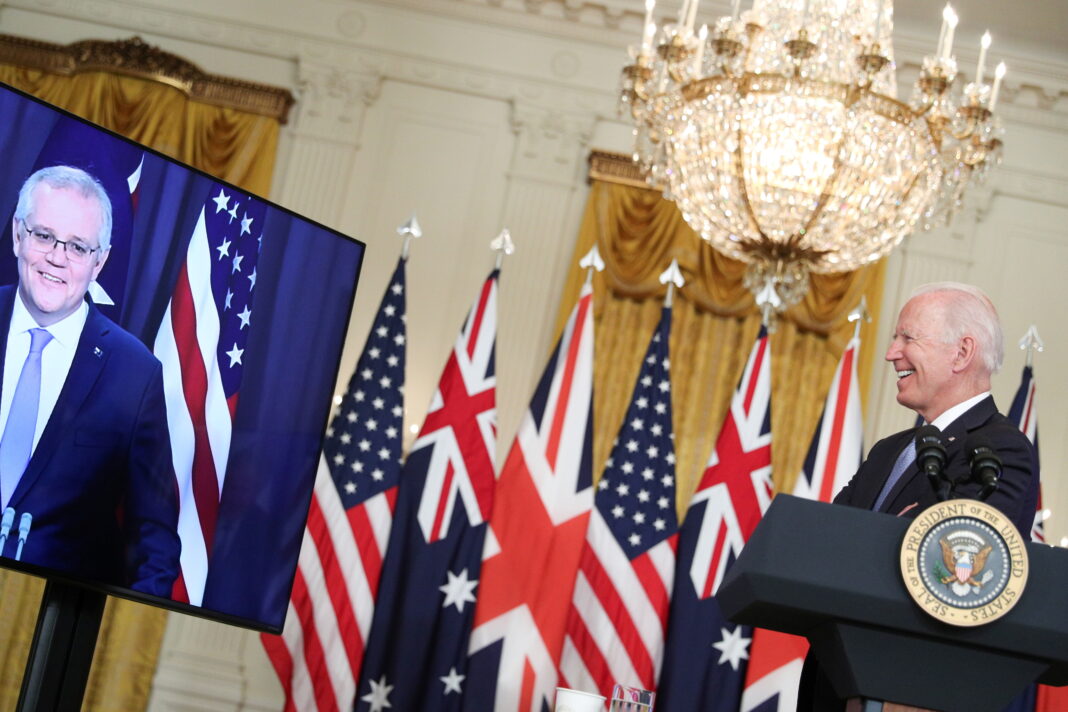The launch of the trilateral pact called AUKUS is a gigantic development in the Indo-Pacific area, but it has deeply irritated China and France and it sets a dangerous precedent for the Treaty of Non-Proliferation
On September 15, the three leaders of the US, UK and Australia announced the birth of a new trilateral pact, called AUKUS. The atmosphere at the press conference was warm and jovial (President Biden called PM Johnson by his first name and addressed PM Morris as “that fellow down under” and “pal”), in stark contrast to some of the previous press conferences, where the topic was the US rushed retreat from Afghanistan. In fact, one can say that AUKUS is the exact opposite of that defeat: Afghanistan signaled US disengagement from the Middle East, AUKUS a further deployment in the Indo-Pacific; Afghanistan was a diplomatic debacle, AUKUS a victory; In Afghanistan the US abandoned an ally, with AUKUS they tightened the bond with a historic friend. Briefly, after Afghanistan the US looked weaker, after AUKUS stronger.
But what is AUKUS? Diplomatically, it is not a momentous change, such was Nixon’s visits to China in the seventies. Many are the bonds already binding these nations: NATO between the UK and the US, the Commonwealth between Australia and the UK (queen Elizabeth II’s face is still depicted on Australian coins), and the intelligence alliance Five Eyes, which includes the three nations plus New Zealand and Canada. The real game changer is the technology and expertise sharing that will deliver a fleet of nuclear submarines to Australia. Thus, Australia will enter the exclusive club of countries with nuclear subs capacities, that, as of now, includes the US, the UK, Russia, India, China and France. What has been stressed by all three leaders is the fact that these new subs will be powered by a nuclear reactor, but they will not be armed by nuclear weapons (after all, that will be in breach of the Treaty of Non-Proliferation).
From a strategic point of view, an Australia armed with nuclear subs changes the face of the Indo Pacific theatre. The alternative to nuclear propulsion is the classic diesel-electric propulsion. The main differences between the two types, other than the nuclear predominance in speed and dimension, are range, and the costal preference of the diesel compared to the deep-water preference of the nuclear: while nuclear subs are stealthier in deeper seas, diesels subs can be more silent near the coast (especially because a diesel engine can be stopped and silenced, while a nuclear reactor cannot). This, combined with the fact that Australian nuclear subs could station in the Chinese Sea for more than 70 days, clearly means that Canberra’s aim is no longer just the defense of their shores, but also Chinese containment.
From this deal three losers emerge.
China
The first loser is, surprisingly to no one, China. Australia, like many nations in the Indo Pacific, has been cautious about picking a side in the mounting confrontation between the US and China. After all, 38% of Australian exports were directed to China in 2019. But after more than a year of harassment by the PRC and increasing tension, Australia clearly picked the American side and China gained a new thorn in its side. One should read a couple of articles of the Global Times, the most nationalistic and caustic tabloid of Chinese production, to understand the Communist Party irritation with this new development.
The Treaty of Non-Proliferation
Even though the acquisition of nuclear subs does not violate directly the TNP, it sets a dangerous precedent, as James Acton of the Carnegie Endowment for International Peace argues. The problem is not Australia, but all nations that would like the acquire nuclear strike capacities and could use developing nuclear subs as a “legal” step in covertly developing nuclear weapons. The level of enrichment of the uranium used in the Virginia and Astute class submarines (the American and British ones on which Australian will be based) is the same used for nuclear weapons.
France
Then there is France, whose company Naval Group has lost a €56 bn contract to supply twelve diesel electric subs to the Royal Australian Navy. Naturally, President Macron was furious, and recalled the ambassadors from Canberra and Washington (snubbing Britain). Obviously, this is a hard blow for French coffers and pride, but the US is already on route to mend the relationship with its ally. After all, France, with its 8.000 soldiers stationed in the pacific theatre, is a fundamental ally in order to contain China.
Finally, one should remember that this development, although grandiose, will not be instantaneous. It will take 18 months just to finish the preliminary step of consultation and the first subs are expected to be delivered not before the mid-30s. Fifteen years are a long period of time in the everchanging Indo-Pacific.
But what is AUKUS? Diplomatically, it is not a momentous change, such was Nixon’s visits to China in the seventies. Many are the bonds already binding these nations: NATO between the UK and the US, the Commonwealth between Australia and the UK (queen Elizabeth II’s face is still depicted on Australian coins), and the intelligence alliance Five Eyes, which includes the three nations plus New Zealand and Canada. The real game changer is the technology and expertise sharing that will deliver a fleet of nuclear submarines to Australia. Thus, Australia will enter the exclusive club of countries with nuclear subs capacities, that, as of now, includes the US, the UK, Russia, India, China and France. What has been stressed by all three leaders is the fact that these new subs will be powered by a nuclear reactor, but they will not be armed by nuclear weapons (after all, that will be in breach of the Treaty of Non-Proliferation).




